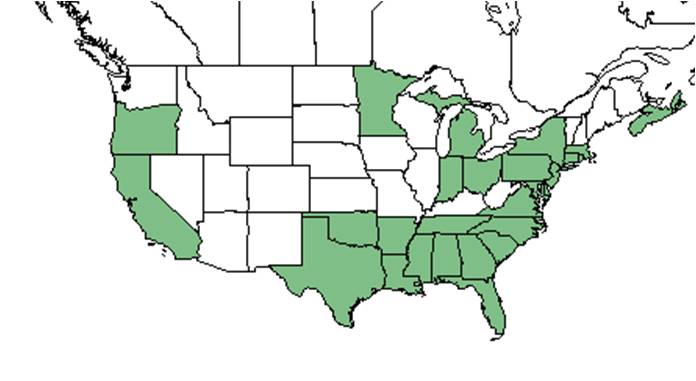Hydrocotyle umbellata
| Hydrocotyle umbellata | |
|---|---|

| |
| Scientific classification | |
| Kingdom: | Plantae |
| Division: | Magnoliophyta - Flowering plants |
| Class: | Magnoliopsida - Dicotyledons |
| Order: | Apiales |
| Family: | Apiaceae ⁄ Umbelliferae |
| Genus: | Hydrocotyle |
| Species: | H. umbellata |
| Binomial name | |
| Hydrocotyle umbellata L. | |

| |
| Natural range of Hydrocotyle umbellata from USDA NRCS Plants Database. | |
Common name: manyflower marshpennywort
Contents
Taxonomic notes
Description
Hyrocotyle umbellata is a perennial terrestrial and aquatic species. The umbrella shaped leaves will dominate groundcover for moist soils or submerged shallow water [1]. The leaves are peltate with veins radiating from the point of the petiole and the blades rounded with heavily notched margins [2]. The star-shaped flowers are small with seperate petals and sepals and five stamen[3].
It is distinguishable from Hydrocotyle ranunculoides by whaving a light green disk at the location of petiole attachment while H. ranunculoides has a light pink disk [2].
Distribution
Occurs from south American throughout central American and the Caribbean and along the Atlantic coast[4].
Ecology
Habitat
H. umbellata is both a terrestrial and aquatic species being found in areas such as swamps, lake shores, shallow water of pond pine flats, sandy peaty ditches, shallow water of flowing streams, moist sands of open flatwoods,and floodplains. It occurs in disturbed areas such as moist roadside ditches, man made ponds, wet pastures, levees, and drainage ditches. Associated species include Eryngium prostratum, Ludwigia arcuata, Panicum hemitomon, and Bacopa (FSU Herbarium).
Growth rate in terrestrial environments is double the growth rate in aquatic environments. The leaves produced in terrestrial environments differ significantly in the structure and morphology from aquatic leaves and cannot acclimate to aquatic conditions, resulting in death. In aquatic conditions, it has been observed to have an increased petiole length and a larger leave with more stomata on the upper than on the lower surface (Reekie and Dawe 2007).
Phenology
The star shaped flowers are small and terminate in umbels[2]. It reproduces both sexually by seed and vegetatively by growth and fragmentation of rhizomes; however, primarily by asexual reproduction (Vasseur 2005). It can bee seen flowering and fruiting March through December (FSU Herbarium).
Seed dispersal
Seed bank and germination
Germination rate is higher in flooded conditions than in moist soil conditions (Wetzel et al. 2001).
Fire ecology
Pollination
The following Hymenoptera families and species were observed visiting flowers of Hydrocotyle umbellata at Archbold Biological Station (Deyrup 2015):
Halictidae: Halictus poeyi
Pompilidae: Episyron conterminus posterus
Sphecidae: Cerceris blakei, Ectemnius rufipes ais, Epinysson mellipes, Hoplisoides denticulatus denticulatus, Oxybelus emarginatus, Tachysphex apicalis, T. similis
Vespidae: Leptochilus alcolhuus, Parancistrocerus salcularis rufulus
Use by animals
Diseases and parasites
Conservation and Management
Cultivation and restoration
Photo Gallery
References and notes
Deyrup, M.A. and N.D. 2015. Database of observations of Hymenoptera visitations to flowers of plants on Archbold Biological Station, Florida, USA.
Florida State University Robert K. Godfrey Herbarium database. URL: http://herbarium.bio.fsu.edu. Last accessed: October 2015. Collectors: Loran C. Anderson, Mel Boreham, J.P. Gillespie, Robert K. Godfrey, D.C. Hunt, Gary R. Knight, R. Komarek, R. Kral, H. Kurz, R.L. Lazor, William Lindsey, Sidney McDaniel, Herbert Monoson, William Platt, R.A. Pursell, Gwynn W. Ramsey, P.L. Redfearn Jr., J. Sincock, Cecil R. Slaughter, H. Larry Stripling, Victoria Sullivan. States and Counties: Florida: Bradford, Brevard, Citrus, Franklin,Gad Hernando, Jackson, Jefferson, Leon, Levy, Liberty, Madison, Martin, Nassau, Okaloosa, Orange, Pinellas, Putnam, Sumter, Taylor, Wakulla, Walton. Georgia: Thomas. Countries: Costa Rica, Panama. Compiled by Tall Timbers Research Station and Land Conservancy.
- ↑ [Wildflower]Accessed December 14, 2015
- ↑ 2.0 2.1 2.2 [Clemson Cooperative Extension]Accessed: December 18, 2015
- ↑ [Go Botany]Accessed: December 17, 2015
- ↑ [Cosewic Assessment and Status Report] Accessed: December 17, 2015